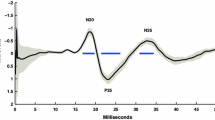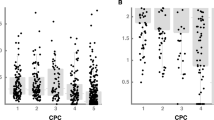Summary
Subcortical and early cortical somatosensory evoked potentials (SEPs) were recorded in 63 comatose patients and classified into five salient SEP grades, which were defined as follows: grade 1, normal SEP; grade 2, SEPs with a clearly recognizable scalp component N20, normal central conduction time but clearly distorted wave N20–P25; grade 3, SEPs with a still recognizable N20 but delayed central conduction time and severely altered wave N20–P25; grade 4, SEPs with absence of N20 but with a more or less recognizable P15; grade 5, SEPs with absence of both N20 and P15. When these five patterns were compared with outcome, it was found that bilaterally normal SEPs or only unilaterally distorted SEPs were generally followed by good outcomes. Bilaterally altered SEPs (grade 2 or 3) were indicative of reduced chances of full recovery. The great majority of patients showing either grade 4 or 5 SEPs died within a few days after the recording session. In 31 patients, it was found post mortem that grade-2 SEPs reflected cortical brain damage, whereas grade-3 SEPs correlated well with subcortical lesions. In post-traumatic patients, this SEP pattern coresponded to diffuse subcortical shearing lesions. Patients with grade 4 or 5 SEPs were found to have severe brain oedema giving rise to transtentorial herniation, which was combined with secondary midbrain haemorrhage and tonsillar herniation in all patients with bilateral grade-5 SEPs.
Similar content being viewed by others
References
Adams JH, Graham DI, Murray LS, Scott G (1982) Diffuse axonal injury due to nonmissile head injury in humans: an analysis of 45 cases. Ann Neurol 12:557–563
Arezzo J, Legatt AD, Vaughan HG (1979) Topography and intracranial sources of somatosensory evoked potentials in the monkey. I. Early components. Electroencephalogr Clin Neurophysiol 46:155–173
Desmeth JE, Cheron G (1980) Central somatosensory conduction in man: neural generators and interpeak latencies of the far-field components recorded from the neck and right or left scalp and earlobes. Electroencephalogr Clin Neurophysiol 50:382–403
Ganes T, Lundar T (1983) The effect of thiopentone on the somatosensory evoked responses and EEG's in comatose patients. J Neurol Neurosurg Psychiatry 46:509–514
Gennarelli TA, Thibault LE, Adams H, Graham DI, Thompson CJ, Marcincin RP (1982) Diffuse axonal injury and traumatic coma in the primate. Ann Neurol 12:564–574
Goldie WD, Chiappa KH, Young RR (1981) Brainstem auditory and short-latency somatosensory evoked responses in brain death. Neurology (NY) 31:248–256
Greenberg RP, Mayer DJ, Becker DP, Miller DJ (1977) Evaluation of brain function in severe human head trauma with multimodality evoked potentials. I. Evoked brain-injury potentials, methods and analysis. J Neurosurg 47:150–162
Greenberg RP, Becker DP, Miller JD, Mayer DJ (1977) Evaluation of brain function in severe human head trauma with multimodality evoked potentials. II. Localisation of brain dysfunction and correlation with posttraumatic neurological conditions. J Neurosurg 47:163–177
Hume AL, Cant BR (1978) Conduction time in central somatosensory pathways in man. Electroencephalogr Clin Neurophysiol 45:361–375
Hume AL, Cant BR (1981) Central somatosensory conduction time after head injury. Ann Neurol 10:411–419
Jennett B, Snoek J, Bond MR, Brooks N (1981) Disability after severe head injury: observations on the use of the Glasgow Outcome Scale. J Neurol Neurosurg Psychiatry 44:285–293
Jones SJ (1977) Short-latency potentials recorded from the neck and scalp following median nerve stimulation in man. Electroencephalogr Clin Neurophysiol 43:853–863
Lindsay KW, Carlin J, Kennedy I, Fry J, McInnes A, Teasdale GM (1981) Evoked potentials in severe head injury: analysis and relation to outcome. J Neurol Neurosurg Psychiatry 44:796–802
Lütschg J, Pfenninger J, Ludin HP, Vasella F (1983) Brainstem auditory evoked potentials and early somatosensory evoked potentials in neurointensively treated comatose children. Am J Dis 137:421–426
Maugière F, Desmeth JE, Courjon J (1983) Astereognosis and dissociated loss of frontal or parietal components of somatosensory evoked potentials in hemispheric lesions. Brain 106:271–311
Nakanishi T, Shimada Y, Sakuta M, Toyokura Y (1978) The initial positive component of the scalp-recorded somatosensory evoked potentials in normal subjects and in patients with neurological disorders. Electroencephalogr Clin Neurophysiol 45:26–34
Newlon PG, Greenberg RP, Enas GG, Becker DP (1983) Effects of therapeutic phenobarbital coma on multimodality evoked potentials recorded from severely head-injured patients. Neurosurgery 12:613–619
Plum F, Posner J (1980) The diagnosis of stupor and coma, 3rd edn. FA Davis, Philadelphia
Sohmer H, Gafni M, Chisin R (1982) Auditory nerve-brain stem potentials in man and cat under hypoxic and hypercapnic conditions. Electroencephalogr Clin Neurophysiol 53:506–512
Sohmer H, Gafni M, Goitein K, Fainmesser P (1983) Auditory nerve-brain stem evoked potentials in cats during manipulation of the cerebral perfusion pressure. Electroencephalogr Clin Neurophysiol 55:198–202
Symon L, Hagardine J, Zawirsky M, Branston N (1979) Central conduction time as an index of ischemia in subarachnoid hemorrhage. J Neurol Sci 44:95–103
Trojaberg W, Jorgensen ED (1973) Evoked cortical potentials in patients with isoelectric EEGs. Electroencephalogr Clin Neurophysiol 35:301–309
Walser H, Mattle H, Keller HM, Janzer R (1985) Early cortical median nerve somatosensory evoked potentials. Prognostic value in anoxic coma. Arch Neurol 42:32–38
Author information
Authors and Affiliations
Rights and permissions
About this article
Cite this article
Walser, H., Emre, M. & Janzer, R. Somatosensory evoked potentials in comatose patients: correlation with outcome and neuropathological findings. J Neurol 233, 34–40 (1986). https://doi.org/10.1007/BF00313989
Received:
Revised:
Accepted:
Issue Date:
DOI: https://doi.org/10.1007/BF00313989




